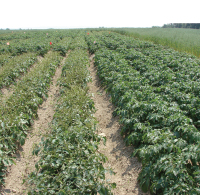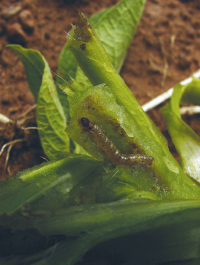
Features
Production
Research
Another product for Colorado potato beetle control: Insecticide with active ingredient coming
Insecticide with active ingredients coming soon
March 4, 2008 By Donna Fleury
Growers will soon have access to a new innovative insecticide, a welcome addition to the pest control toolbox. With a new chemistry and new mode of action, growers will be able to expand their management options.
 |
| Rynaxypyr trial in a field near Îles d’Orleans, Que., 2007. Left side of the picture shows untreated potatoes with significant defoliation from Colorado potato beetle feeding. Right side of the picture shows protection provided by 75 grams active ingredient per hectare rate of rynaxypyr. Photo courtesy of Dupont Canada
|
Growers will soon have access to a new innovative insecticide, a welcome addition to the pest control toolbox. With a new chemistry and new mode of action, growers will be able to expand their management options. Rynaxypyr is a new insecticide active ingredient discovered and developed by DuPont. It will be marketed under the name Coragen in potatoes. In addition to potatoes, rynaxypyr has been submitted for registration on a broad range of vegetable and fruit crops as a foliar application.
“Rynaxypyr is from a completely new family of chemistry,” explains Adam Vaughan, product registration manager, DuPont Canada. “It is the first active ingredient from the anthranilic diamide class of insecticides and offers a totally new mode of action.” Rynaxypyr will provide long-lasting, broad spectrum chewing insect control for potatoes and other vegetables, fruits, other specialty crops and turf.
“Rynaxypyr is the first product to be simultaneously reviewed by Canada, the U.S., Europe and Australia under an Organization for Economic Co-operation and Development (OECD) work-sharing project,” says Vaughan. This project is aimed at an accelerated review and approval timeline and regulatory harmonization. Through this process, the product will be reviewed in 14 months from the time of submission. “This process ensures that Canadian growers have access to the same products, for the same crops as growers in the U.S. and other countries. It also ensures that Maximum Residue Levels (MRL) are established at the same time in as many countries as possible.” The application for international CODEX MRL has also been accepted for review.
“We take our hats off to DuPont for taking a real global leadership role with this registration approach,” says Craig Hunter, technical advisor, pesticides and minor use, Ontario Fruit and Vegetable Growers’ Association (OFVGA). “They are really a ‘poster child’ of how growers would like to see companies approach new registrations. We hope other companies follow their lead.” Having the product registered globally at the same time ensures growers are facing the same residue tolerances in all countries, and trade is therefore not an issue in terms of pesticide use.
With an entirely new chemistry and novel mode of action, rynaxypyr will expand the range of tools growers have to address pest problems and the potential of resistance. “We’ve already lost some products over the past few years because of resistance, or voluntary elimination in the face of the U.S. FQPA review program, and other standbys such as Guthion are slated to be taken off the market in 2012,” says Hunter. “Therefore, it is exciting to see some new chemistries being brought in that will have spectrums of activity that will eliminate or greatly reduce the impact of losing these old standbys we’ve relied on for years.”
 |
| A European corn borer larvae feeding on potato. Photo courtesy of Dupont Canada |
For growers, Coragen research has demonstrated excellent control of Colorado potato beetle along with extended residual control. “Because it is a completely new mode of action, Coragen presents an effective option for control of beetles that are resistant to existing products,” says Vaughan. “Coragen also provides a useful tool in resistance management strategies since it can be used in rotations to help delay the development of resistance to existing products.” In addition, research is showing that Coragen provides outstanding control against European corn borer, a major potato pest in Prince Edward Island and New Brunswick. “In 2007, we conducted some large scale research permit field trials across all the geographies including Manitoba, Ontario, Quebec and P.E.I., which confirmed all the research we had done previously.”
Hunter adds that DuPont has also conducted ongoing trials with rynaxypyr in collaboration with a number of members of the OFVGA. “So far, growers have been very pleased with the results on potatoes, apples and other crops.” As a new chemistry, rynaxypyr provides growers with good management options to prevent resistance from developing. “We want to encourage growers to learn how to use this new chemistry correctly and to use it in programs so they don’t risk losing it to resistance issues.” Hunter encourages growers to use it judiciously, learn how to use it, determine how it fits in rotation and get good advice from company representatives, extension staff and research people.
Rynaxypyr was accepted for review under the reduced risk category. It is applied at low use rates and has a unique mode of action. The many regulatory studies conducted over the past few years demonstrate the effectiveness and extraordinarily low toxicity of rynaxypyr to mammals, birds and fish. This product achieves the goal of delivering safe and environmentally sustainable options for growers. In terms of registration status, rynaxypyr is currently under review and Coragen is expected to be available for the 2008 season.
Print this page